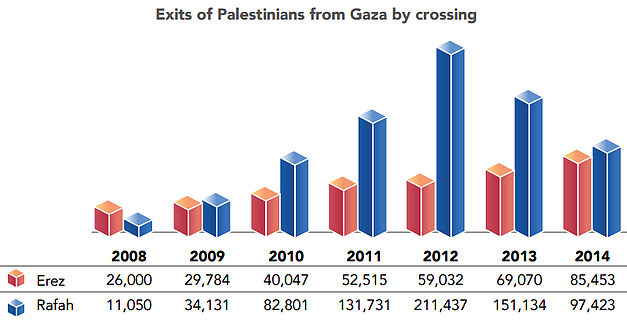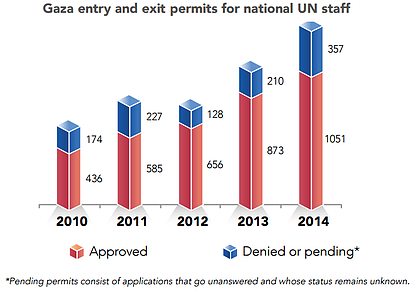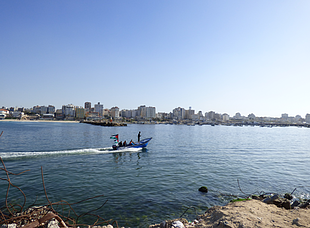Increase in volume of Departures from Gaza via Israel; crossing with Egypt remains closed
Relaxation in the criteria for exit permits via Erez crossing
The upward trend registered in previous years in the number of Palestinians allowed to exit Gaza through the Erez crossing with Israel (mainly to the West Bank) continued into 2014, with a 24 per cent increase compared with 2013. This was particularly pronounced in the second half of the year following the relaxation of Israeli eligibility criteria for exit permits (see box below) in the wake of the July-August hostilities. Despite this improvement, access continues to be largely restricted to medical cases and their escorts, businessmen and traders, and staff of international organizations, with movement to the West Bank denied to most Palestinians from Gaza
Historically, Erez has been the main crossing to and from Gaza, particularly for Palestinians working as labourers in Israel; these made up the bulk of Palestinians who crossed on a daily basis prior to the start of the second Intifada in 2000. The numbers declined significantly in subsequent years, particularly from 2006 when Israel halted the entry of day labourers, and following the Hamas takeover of the Gaza Strip and the imposition of the blockade in 2007. In 2008, only 26,000 people crossed via Erez in the entire year, the equivalent of one day’s passage in 2000.

The relaxation measures introduced this year are reflected in the higher number of patients permitted to travel through Erez to medical facilities in Israel, the West Bank, including East Jerusalem, and Jordan. The volume of permit applications rose by 33 per cent from 2013 to 2014, with the number of approvals increasing by 23 per cent (from 12,120 to 14,920), although the number of denied permits also rose from 40 to 522.
Record number of permits issued for national UN staff
In 2014 the Israeli authorities approved the highest numbers of permits since 2010 for national UN staff traveling in and out of Gaza. In the period following the summer hostilities (September through December), the average processing time for these applications climbed from 10 to 15 day. The Israeli authorities attributed the increased delays to a significant increase in permit applications for Erez during the post-hostilities period as a result of the prolonged closure of the Egyptian-controlled Rafah crossing. In addition, traffic increased following Israel’s relaxation of the criteria used for the wider population.
Palestinian access via Rafah crossing declines further in 2014
The decline in the movement of people via the Rafah border crossing with Egypt began in mid-2013 and continued into 2014; during the latter, the crossing was closed for a total of 207 days, or 57 per cent of the year. Since mid-2013, movement has been largely limited to patients, students, pilgrims, and foreign passport and residency permit holders.

The restrictions imposed on the Erez crossing from 2000 turned Rafah into the primary exit and entry point to the wider world for Palestinians in Gaza and the figures rose significantly from 2009. This trend continued into the first six months of 2013, with over 55,000 people crossing Rafah in both directions in June.
Subsequent political uncertainty and military operations in northern Sinai led the Egyptian authorities to impose severe restrictions that drastically reduced the passage of pedestrians in both directions. The volume increased in August and September 2014, but declined again after 24 October following an attack in the Sinai Peninsula in which over 30 Egyptian military personnel were killed. This incident triggered Rafah’s closure for the rest of the year, with a few exceptional openings.
The prolonged closure is particularly detrimental to medical patients, both those seeking to exit Gaza for treatment for advanced cancer, renal and heart diseases, and those stranded in Egypt whose continued treatment in Gaza is delayed. There are also reports of Palestinian travelers trying to return to Gaza via Cairo airport being denied boarding, detained or returned to their county of departure due to Egyptian visa and residence permit requirements. The Palestinian Embassy in Cairo has reported having to provide financial support or rented accommodation to stranded Palestinians.[1] According to the Border and Crossing Authority, at the end of 2014 around 17,000 registered people, including medical patients, were waiting to exit Gaza, in addition to an estimated 37,000 others wishing to exit Gaza, including to Saudi Arabia for pilgrimage.
Main relaxations of criteria for exit permits via Israel
Daily quota for married merchants increased from 200 to 400; the total pool of 3,000 permits, up from 2,000; age requirement lowered from 35 to 26. A quota of 200 permits per week was also introduced for businessmen’s wives over the age of 30.
Palestinians from Gaza may now apply to visit second-degree relatives, such as grandparents, in the West Bank; previously, only first degree relatives were allowed. The age of minors who can accompany permitted adults was raised from six to 15.
A daily quota of 80 medical patients whose condition is considered ‘not urgent’ may now travel from Gaza to the West Bank, in addition to a daily quota of 30 people who were injured during the July-August hostilities.
A monthly quota for up to 100 medical workers from Gaza for training in West Bank hospitals, including in East Jerusalem.
For the first time in five years, Israel permitted 1,200 Gaza residents to travel to the West Bank, including East Jerusalem, for the feast of Eid al Adha between 5 and 7 October. A weekly quota of up to 200 individuals over the age of 60 permitted to go to East Jerusalem for Friday prayers.
Students from Gaza are now eligible for permits to transit via the West Bank to study abroad, but remain prohibited from studying in the West Bank itself, including East Jerusalem.[2]
Escaping Gaza
 In the aftermath of the devastation resulting from the July-August hostilities and the restrictions on the Rafah and Erez crossings, there are increasing reports of Palestinians attempting to smuggle themselves out of Gaza into Israel and Egypt, and to countries beyond. The Protection Cluster reported in November that at least 17 young Palestinians were arrested while attempting to cross into Israel, and cited media reports of more than 136 Palestinian youths attempting to cross to Israel since the end of the July-August hostilities. The majority, reportedly, were attempting to find work in Israel due the depressed economic situation in Gaza.
In the aftermath of the devastation resulting from the July-August hostilities and the restrictions on the Rafah and Erez crossings, there are increasing reports of Palestinians attempting to smuggle themselves out of Gaza into Israel and Egypt, and to countries beyond. The Protection Cluster reported in November that at least 17 young Palestinians were arrested while attempting to cross into Israel, and cited media reports of more than 136 Palestinian youths attempting to cross to Israel since the end of the July-August hostilities. The majority, reportedly, were attempting to find work in Israel due the depressed economic situation in Gaza.
Others are reportedly smuggling themselves to Egypt through tunnels with the intention of continuing onwards clandestinely to Europe by sea in search of asylum and better economic opportunities. This phenomenon came to light when a smuggler’s boat capsized in the Mediterranean on 13 September, reportedly drowning at least 15 Palestinians from Gaza. In an earlier incident on 10 September, smugglers rammed a vessel off the coast of Malta and up to 500 migrants died, among whom over 100 are reported to have been from Gaza. In October, 68 Palestinians were deported back to Gaza through Rafah after being apprehended in Alexandria by Egyptian security forces while attempting to smuggle themselves to Italy.
[1] See “1.8 million people ‘locked in’ due to the closure of Rafah crossing and Israel’s blockade”, OCHA Humanitarian Bulletin, November 2014.
[2] All figures include Israeli and Palestinian casualties that occurred during attacks perpetrated by Palestinians from the West Bank in Israel, including in West Jerusalem.









